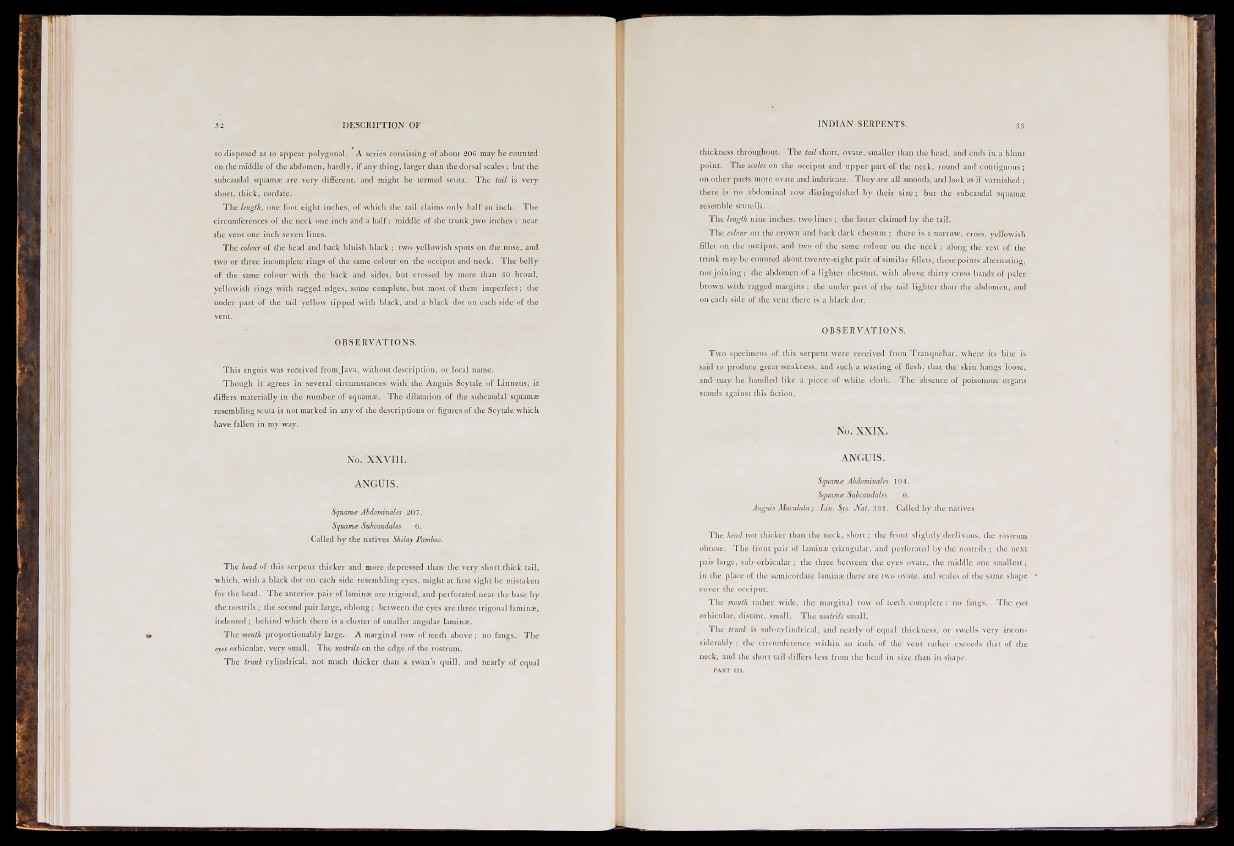
32 DE S C R I P T I O N OF
so disposed as to appear polygonal. A series consisting of about 206 may be counted
on the middle of the abdomen, hardly, if any thing, larger than the dorsal scales ; but the
subcaudal squams are very different, and might be termed scuta. The tail is very
short, thick, cordate.
The length, one foot eight inches, of which the tail claims only half an inch. The
circumferences of the neck one inch and a hal f ; middle of the trunk _t\vo inches ; near
the vent one inch seven lines.
The colonr of the head and back bluish black ; two yellowish spots on the nose, and
two or three incomplete rings of the same colour on the occiput and neck. The belly
of the same colour with the back and sides, but crossed by more than 30 broad,
yellowish rings with ragged edges, some complete, but most of them imperfect; the
under part of the tail yellow tipped with black, and a black dot on each side of the
vent.
O B S E R V A T I O N S .
This anguis was received from J a v a , without description, or local name.
Though it agrees in several circumstances with the Anguis Scytale of Linneus, it
differs materially in the number of squamae. The dilatation of the subcaudal squamas
resembling scuta is not marked in any of the descriptions or figures of the Scytale which
have fallen in my way.
No. XXVIII.
ANGUIS.
Squamce Abdominales 207.
Squamie Subcaudales 6.
Called by the natives Shilay Pamhoo.
The head of this serpent thicker and more, depressed than the very short thick tail,
which, with a black dot on each side resembling eyes, might at first sight be mistaken
for the head. The anterior pair of lamin® are trigonal, and perforated near the base by
the nostrils ; the second pair large, oblong ; between the eyes are three trigonal laminae,
indented ; behind which there is a cluster of smaller angular laminae.
The mouth proportionably large. A marginal row of teeth above ; no fangs. Tlie
eyes orbicular, very small. The nostrils on the edge of the rostrum.
The trunk cylindrical, not much thicker than a swan's quill, and nearly of equal
I N D I A N SERPENTS. 33
thickness throughout. The tail short, ovate, smaller than the head, and ends in a blunt
point. The, scales on the occiput and upper part of the neck, round and contiguous ;
on other parts more ovate and imbricate. They are all smooth, and look as if varnished ;
there is no abdominal row distinguished by their size ; but the subcaudal squamae
resemble scutella.
The length nine inches, two lines ; the latter claimed by the tail.
The colour on the crown and back dark chesnut; there is a narrow, cross, yellowish
fillet on the occiput, and two of the same colour on the neck ; along the rest of the
trunk maybe counted about twenty-eight pair of similar fillets, these points alternating,
not joining ; the abdomen of a lighter chesnut, with above thirty cross bands of paler
brown with ragged margins ; the under part of the tail lighter than the abdomen, and
on eacli side of the vent there is a black dot.
O B S E R V A T I O N S .
Two specimens of this serpent were received from Tranquebar, where its bite is
said to produce great weakness, and such a wasting of flesh, that the skin hangs loose,
and may be handled like a piece of white cloth. The absence of poisonous organs
stands against this fiction.
No. XXIX.
ANGUIS.
Squamce Abdominales 194.
Squamae Subcaudales 6.
Anguis Macúlala; Lin. Sys. Nat. 391. Called by the natives
The head not thicker than the neck, sliort; the front slightly declivous, the rostrum
obtuse. The front pair of lamina; triangular, and perforated by the nostrils ; the next
pair large, snb-orbicular ; the three between the eyes ovate, the middle one smallest ;
in the place of the semicordate laminae there are two ovate, and scales of the same shaj^e
cover the occiput.
The mouth rather wide, the marginal row of teeth complete : no fangs. The eyes
orbicular, distant, small. The nostrils small.
The trunk is sub-cylindrical, and nearly of equal thickness, or swells very inconsiderably
; the circumference within an inch of the vent rather exceeds that of the
neck, and the short tail differs less from the head in size than in shape.